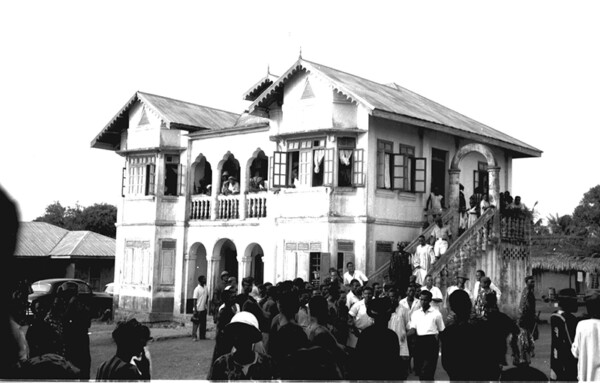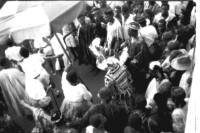(Click on any image to enlarge it.)
Onitsha and Aguleri are linked directly by the Anambra River, which flows nearly north to south from Aguleri to its confluence with the Niger River just above Onitsha. But the two towns are separated by many miles of road. In the early 1960s, we would drive from Onitsha some twenty miles east on the highway to Enugu, only turning north where a tarmac road traversed the uplands from Awka to Aguleri. One could choose to drive directly north through Nsugbe, but these dirt roads could be impassable during the rainy season, and they entailed much slower driving..
I had very little idea why we were going to this location at this time, except that there was a harvest ritual there that Byron (below left) thought we would find worth seeing. Throughout our times together, he had a way of suggesting to me on short notice a trip that would be interesting, and we would go. In the fall of 1960, I knew nothing about Aguleri, whereas 12 years later I would publish a book1 that would emphasize the importance of this location for all of Ndi-igbo history and beyond — for the history of the Yoruba, Edo, Igala and other peoples who trace their origins back to the region of the Niger-Benue Confluence..
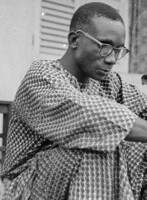
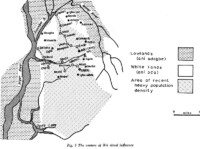

The map directly left here hints at this history: somewhere in the vicinity of a thousand years ago, Aguleri was one of the ritual foci of the Nri kingdom, an early Bronze Age center which produced astonishing cultural productions and apparently extended strong influence far beyond its borders. The complex sculpture at right is one item of a massive treasure produced by the ancestors of the Nri complex.2 And this cultural efflorescence — which faded gradually but severely over time — was connected to a deep geological feature of this landscape: the river Anambra ( (in Igbo, omambala, “plain floods”) is part of a vast and regular flooding process that has produced the incredibly fertile plain which the Ndi-Igbo label “Anam” ((See in Part One of this website: “Instabilities ancient (nateural) and recent (cultural and natural) for detailed discussionn of this major environmental condition.))
But in 1960, neither Byron nor I, nor probably any of the actors whose play we were about to witness had anything like full awareness of the historical grounds on which we all were there to celebrate the Emergence of a figure of royal importance.
I should say, before presenting this description, that in my early stages of the fieldwork I was tentatively experimenting in every way, not least in the use of my very cheap Aires 35mm camera (the best I as an impoverished graduate student could afford). I don’t remember what choice of B/W film I was trying, but obviously the results from this adventure speak for themselves (amateur at best — the great Ndi-Igbo ethnographer G.I. Jones produced far better images in the 1930s and 40s). The entire array of 1960s images you see in the A Mighty Tree website were produced with this camera.

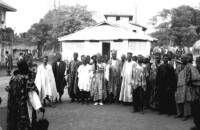
Byron had introduced me as an American scholar wanting to record some of Aguleri social life, so I was free to start at ground level, where I photographed these elders charged with some of the organization (left). Soon after the Aguleri Market women approached en masse, carrying their ornate market stools on their heads (right). I decided I needed a better vantage point, so I retreated to the palace stairs where I was shown a secluded room that suited my purpose.

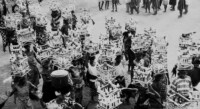 These very elaborate ritual objects reflect ;in some measure the central importance of women’s trading activities in the town. At right, elite women of royal connections are escorted to places of comfort and privilege.
These very elaborate ritual objects reflect ;in some measure the central importance of women’s trading activities in the town. At right, elite women of royal connections are escorted to places of comfort and privilege.

 As people gathered and waited, social groups with various affiliations to the palace proceeded through the crowd, accompanied by their orchestras. At left, a group with various drummers. At right, one led by a trumpeter.
As people gathered and waited, social groups with various affiliations to the palace proceeded through the crowd, accompanied by their orchestras. At left, a group with various drummers. At right, one led by a trumpeter.
The Hunters’ Association danced through, the hunters clustering around their central icon (center). I went downstairs to ground level for a closer look. While ram’s horns are most prominentfigures in the image held overhead b y the dancer,, a closeup view (right) shows that it also contains animal skulls inside, looking out, and also cloth representations of what look like animal paws.
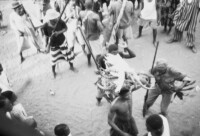
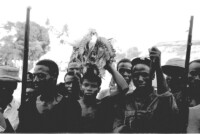
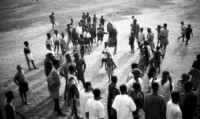
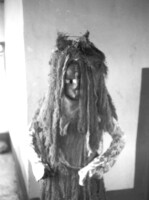
While people are waiting for further events to occur, sometimes Incarnate Dead (ghostly masked figures) will emerge to dance before crowds. At left, one of these performs before a group of ghost-initiated boys and men (with certain special exceptions, no females should be present). At right, one of these creatures appeared before me and allowed me to take its picture (though, at that time, I was an uninitiated male).
Eventually, a very large ground has assembled around the open space before the palace (left) — here you see one side of the crowd. Then, beneath my vantage window in the palace, I see below, the Obi being prepared by attendants fo his Emergence. He wears some bright feathers on his crown (at right).
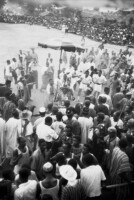
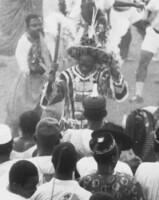
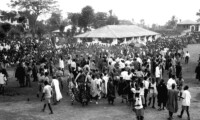 So here the Obi of Aguleri Emerges from his retreat (far left), far below his covering parasol. In the closeup, near left, you see his broad-rimmed hat stuffed with many fathers,and his very colorful gown. (He appears to be wielding a wooden representation of a rifle.) At right, he has so merged his full being into the vast crowd that you can only know his presence by his parasol.
So here the Obi of Aguleri Emerges from his retreat (far left), far below his covering parasol. In the closeup, near left, you see his broad-rimmed hat stuffed with many fathers,and his very colorful gown. (He appears to be wielding a wooden representation of a rifle.) At right, he has so merged his full being into the vast crowd that you can only know his presence by his parasol.
